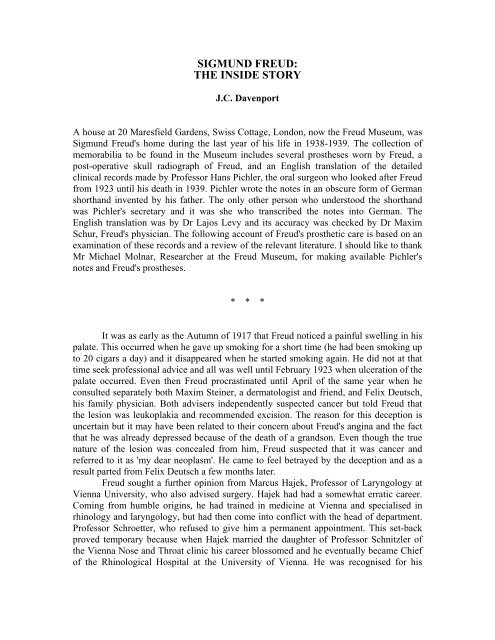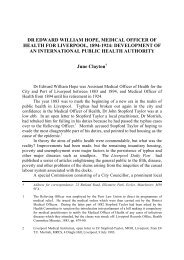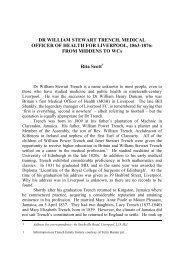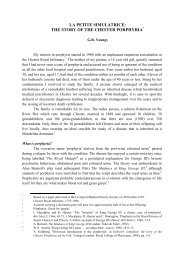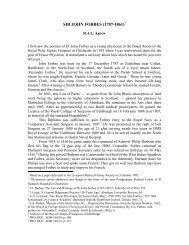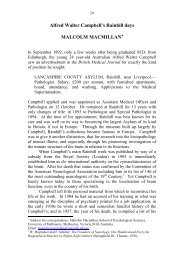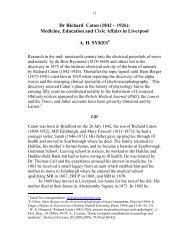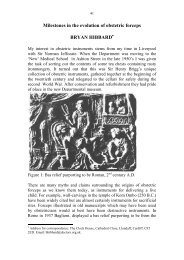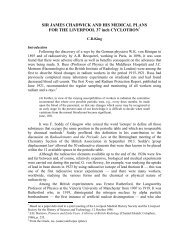Sigmund Freud: the inside story
Sigmund Freud: the inside story
Sigmund Freud: the inside story
You also want an ePaper? Increase the reach of your titles
YUMPU automatically turns print PDFs into web optimized ePapers that Google loves.
SIGMUND FREUD:<br />
THE INSIDE STORY<br />
J.C. Davenport<br />
A house at 20 Maresfield Gardens, Swiss Cottage, London, now <strong>the</strong> <strong>Freud</strong> Museum, was<br />
<strong>Sigmund</strong> <strong>Freud</strong>'s home during <strong>the</strong> last year of his life in 1938-1939. The collection of<br />
memorabilia to be found in <strong>the</strong> Museum includes several pros<strong>the</strong>ses worn by <strong>Freud</strong>, a<br />
post-operative skull radiograph of <strong>Freud</strong>, and an English translation of <strong>the</strong> detailed<br />
clinical records made by Professor Hans Pichler, <strong>the</strong> oral surgeon who looked after <strong>Freud</strong><br />
from 1923 until his death in 1939. Pichler wrote <strong>the</strong> notes in an obscure form of German<br />
shorthand invented by his fa<strong>the</strong>r. The only o<strong>the</strong>r person who understood <strong>the</strong> shorthand<br />
was Pichler's secretary and it was she who transcribed <strong>the</strong> notes into German. The<br />
English translation was by Dr Lajos Levy and its accuracy was checked by Dr Maxim<br />
Schur, <strong>Freud</strong>'s physician. The following account of <strong>Freud</strong>'s pros<strong>the</strong>tic care is based on an<br />
examination of <strong>the</strong>se records and a review of <strong>the</strong> relevant literature. I should like to thank<br />
Mr Michael Molnar, Researcher at <strong>the</strong> <strong>Freud</strong> Museum, for making available Pichler's<br />
notes and <strong>Freud</strong>'s pros<strong>the</strong>ses.<br />
* * *<br />
It was as early as <strong>the</strong> Autumn of 1917 that <strong>Freud</strong> noticed a painful swelling in his<br />
palate. This occurred when he gave up smoking for a short time (he had been smoking up<br />
to 20 cigars a day) and it disappeared when he started smoking again. He did not at that<br />
time seek professional advice and all was well until February 1923 when ulceration of <strong>the</strong><br />
palate occurred. Even <strong>the</strong>n <strong>Freud</strong> procrastinated until April of <strong>the</strong> same year when he<br />
consulted separately both Maxim Steiner, a dermatologist and friend, and Felix Deutsch,<br />
his family physician. Both advisers independently suspected cancer but told <strong>Freud</strong> that<br />
<strong>the</strong> lesion was leukoplakia and recommended excision. The reason for this deception is<br />
uncertain but it may have been related to <strong>the</strong>ir concern about <strong>Freud</strong>'s angina and <strong>the</strong> fact<br />
that he was already depressed because of <strong>the</strong> death of a grandson. Even though <strong>the</strong> true<br />
nature of <strong>the</strong> lesion was concealed from him, <strong>Freud</strong> suspected that it was cancer and<br />
referred to it as 'my dear neoplasm'. He came to feel betrayed by <strong>the</strong> deception and as a<br />
result parted from Felix Deutsch a few months later.<br />
<strong>Freud</strong> sought a fur<strong>the</strong>r opinion from Marcus Hajek, Professor of Laryngology at<br />
Vienna University, who also advised surgery. Hajek had had a somewhat erratic career.<br />
Coming from humble origins, he had trained in medicine at Vienna and specialised in<br />
rhinology and laryngology, but had <strong>the</strong>n come into conflict with <strong>the</strong> head of department.<br />
Professor Schroetter, who refused to give him a permanent appointment. This set-back<br />
proved temporary because when Hajek married <strong>the</strong> daughter of Professor Schnitzler of<br />
<strong>the</strong> Vienna Nose and Throat clinic his career blossomed and he eventually became Chief<br />
of <strong>the</strong> Rhinological Hospital at <strong>the</strong> University of Vienna. He was recognised for his
detailed knowledge of <strong>the</strong> anatomy of <strong>the</strong> nasal sinuses but considered by his colleagues<br />
to be only a mediocre surgeon.<br />
Hajek operated on <strong>Freud</strong> on 20 April, 1923, and undertook a partial resection of<br />
<strong>the</strong> lesion. <strong>Freud</strong>'s short stay in hospital was characterised by apparent professional<br />
neglect. A severe postoperative haemorrhage during <strong>the</strong> night nearly cost <strong>Freud</strong> his life,<br />
but help was summoned in time by a mentally retarded dwarf with whom <strong>Freud</strong> was<br />
sharing a small side ward. The histopathology of <strong>the</strong> excised specimen was reported on<br />
by Jakob Erdheim, a pathologist who was unmarried, working 16 hours a day except on<br />
Sundays and was possibly suffering from Kleinfelter's Syndrome. The diagnosis,<br />
squamous cell carcinoma, was still kept from <strong>Freud</strong>. Hajek advised radio<strong>the</strong>rapy,<br />
however, and this was undertaken by Guido Holzknecht.<br />
Because <strong>Freud</strong>'s condition continued to deteriorate, in September 1923 Deutsch<br />
arranged for <strong>Freud</strong> to see Professor Hans Pichler. Pichler was noted as a modest and kind<br />
oral surgeon. He was keen on sporting challenges and once won a family bet by cycling<br />
15km and climbing a 2,100m peak before breakfast. In old age he broke an ankle while<br />
ski-jumping. He abandoned his general surgical training in Vienna because he developed<br />
eczema from <strong>the</strong> carbol spray used to disinfect <strong>the</strong> hands. He <strong>the</strong>n took up dentistry, and<br />
in 1902 studied under G.V. Black at Northwestern University School of Dentistry in<br />
Chicago. On returning to Vienna he taught dentistry for thirty years, writing 125 papers<br />
and several textbooks. He translated G.V. Black into German and finally produced a<br />
three-volume work. Surgery of <strong>the</strong> Mouth and Jaws.<br />
The first consultation, on 27 September at Pichler's rooms in 1 Lichtenfelsgasse,<br />
Vienna, led Pichler to note a crater-shaped ulcer on <strong>the</strong> posterior aspect of <strong>the</strong> right<br />
maxillary tuberosity and a palpable sub-mandibular node. Pichler decided to operate on<br />
<strong>Freud</strong> and planned <strong>the</strong> procedure with meticulous care. His approach was influenced by<br />
Claude Martin who, as early as 1889, had stressed <strong>the</strong> importance of immediate<br />
pros<strong>the</strong>tic obturation for maxillectomy patients. Pichler's preparations consisted of<br />
rigorous oral hygiene, replacing defective dental restorations, fitting gold inlays in certain<br />
teeth to help retain and support <strong>the</strong> obturator, and constructing a vulcanite surgical<br />
pros<strong>the</strong>sis which he allowed <strong>Freud</strong> to wear for a trial period pre-operatively to ensure that<br />
it was satisfactory. In addition Pichler practised his planned surgical procedures on<br />
cadavers. These preparations were completed within a few days and <strong>the</strong>n Pichler was<br />
ready to proceed.<br />
The operation was carried out in two stages on 4 and 11 October, 1923. In <strong>the</strong> first<br />
stage Pichler ligated <strong>the</strong> right external carotid artery and removed <strong>the</strong> submandlbular<br />
nodes. In <strong>the</strong> second he reflected a facial flap and carried out a maxillectomy, sectioning<br />
anteriorly through <strong>the</strong> right canine region and preserving <strong>the</strong> soft palate posteriorly. A<br />
coronoidectomy was also performed. The maxillectomy cavity was lined with a split skin<br />
graft supported by gutta percha on <strong>the</strong> surgical obturator which was retained by clasps.<br />
All this was done under a local anaes<strong>the</strong>tic and reputedly <strong>Freud</strong> slept through most of <strong>the</strong><br />
operation. Schur (see below) referred to a large surgical obturator of sectional design but<br />
<strong>the</strong>re is no reference in Pichler's notes to such an appliance. Pichler's main concern after<br />
<strong>the</strong> second operation was whe<strong>the</strong>r he had been radical enough, and, indeed, on noting a<br />
recurrence on month later, on 12 November he operated yet again and removed <strong>the</strong><br />
pterygold process and most of <strong>the</strong> right side of <strong>the</strong> soft palate, leaving a posterior margin<br />
about 1cm in width.
On 17 November <strong>Freud</strong> underwent <strong>the</strong> Steinach operation carried out by Victor<br />
Blum. This involved ligation of <strong>the</strong> vas deferens supposedly to stimulate <strong>the</strong> secretion of<br />
<strong>the</strong> testicular hormone and hopefully rejuvenate <strong>the</strong> patient. As cancer was considered to<br />
be a disease of old age this rejuvenation was expected to have a beneficial effect on<br />
<strong>Freud</strong>'s tumour. However, <strong>Freud</strong> recorded later that he failed to detect any benefit<br />
whatsoever from this procedure.<br />
Shortly afterwards <strong>the</strong> soft palate broke down completely and so <strong>Freud</strong> was left<br />
with a maxillary defect which presented considerable difficulties in achieving pros<strong>the</strong>tic<br />
obturation. As a result, obturator stability, speech, smoking and eating remained huge<br />
problems for <strong>Freud</strong> for <strong>the</strong> remaining sixteen years of his life - problems which were<br />
aggravated by trismus.<br />
* * *<br />
At this stage (November 1923) <strong>Freud</strong> finally parted with Deutsch whom he felt<br />
had left him down badly by keeping <strong>the</strong> true nature of <strong>the</strong> illness from him. For a while<br />
<strong>Freud</strong> received occasional medical advice from Ludwig Braun, a cardiologist, Lagos<br />
Levy, a physician from Budapest, and Oskar Re, a paediatrician. However, Pichler<br />
continued to strive to minimise <strong>Freud</strong>'s problems by giving his continual support - thus,<br />
in 1924 he saw <strong>Freud</strong> 74 times, and eight years later, in 1932, he saw him 92 times.<br />
The pros<strong>the</strong>ses were constructed in vulcanite and gold. In <strong>the</strong> area of <strong>the</strong><br />
maxillary detect <strong>the</strong>y were essentially simple cover plates, since <strong>the</strong> trismus made it<br />
impossible to insert an obturator which extended far into <strong>the</strong> cavity. Gutta percha and<br />
wax were <strong>the</strong>n often used as functional reline materials to improve <strong>the</strong> fit of <strong>the</strong> ' clod', or<br />
obturator portion. Stability was always a problem, with <strong>the</strong> result that Pichler had<br />
eventually and reluctantly to supplement retentive gallery clasps with springs. These<br />
joined upper and lower dentures and by forcing <strong>the</strong> dentures apart were supposed to keep<br />
<strong>the</strong> dentures in place. However <strong>the</strong>y were never very satisfactory. On several occasions<br />
<strong>Freud</strong> became so frustrated by <strong>the</strong> springs that he removed <strong>the</strong>m. Pichler would often use<br />
duplication techniques when replacement obturators were required, employing <strong>the</strong><br />
previous pros<strong>the</strong>ses as templates. By March 1927 a fifth pros<strong>the</strong>sis was required of<br />
Pichler. This is described in his records as weighing 75g (without its springs), having a<br />
hollow obturator portion which was closed with a stopper, and being retained by a hinge<br />
clasp and springs. <strong>Freud</strong> received excellent support at home. The key figure was his<br />
devoted daughter Anna who was his self-appointed nurse and was <strong>the</strong> only person <strong>Freud</strong><br />
would allow to help with <strong>the</strong> cleaning, insertion and removal of <strong>the</strong> pros<strong>the</strong>ses.<br />
By 1928 <strong>Freud</strong> was having so much trouble with his pros<strong>the</strong>ses that he turned in<br />
desperation for help to ano<strong>the</strong>r dentist, Dr Schroeder, who was Director of <strong>the</strong> Division of<br />
Pros<strong>the</strong>tics at <strong>the</strong> University of Berlin. Schroeder undertook <strong>the</strong> provision of a new<br />
pros<strong>the</strong>sis in Berlin and trained a local dentist, Dr Joseph Weinmann, to undertake <strong>the</strong><br />
subsequent minor day-today adjustments. Weinmann was later to become Professor of<br />
Dentistry at Chicago. It was he who recommended topical applications of orthoform, a<br />
cocaine-like drug, to <strong>the</strong> maxillectomy cavity to alleviate <strong>Freud</strong>'s discomfort. Winmann's<br />
physician at that time was Maxim Schur and <strong>Freud</strong> engaged him to replace Deutsch.
Schur, who specialised in internal medicine in Vienna and later became a psychoanalyst<br />
in New York, cared for <strong>Freud</strong> from 1928 until <strong>the</strong> latter's death in 1939. At <strong>the</strong>ir first<br />
meeting <strong>Freud</strong> extracted a promise from Schur that he would always be told <strong>the</strong> truth and<br />
that when <strong>the</strong> time came he would not be allowed to suffer unnecessarily. The new<br />
Schroeder dentures were a great improvement on <strong>the</strong> old ones (<strong>Freud</strong> estimated 70%).<br />
They were supported and retained by extra-coronal attachments extending posteriorly<br />
from a bridge which joined <strong>the</strong> upper anterior teeth. Pichler was impressed when he saw<br />
<strong>the</strong> result but was worried that failure of <strong>the</strong> bridge through loosening of <strong>the</strong> 'pillars'<br />
would result in a catastrophe.<br />
The pros<strong>the</strong>ses provided satisfactory service for about three years until 1931,<br />
when friends of <strong>Freud</strong> persuaded a ra<strong>the</strong>r reluctant Professor Kazanjian, who was on a<br />
visit from <strong>the</strong> United States to Berlin, to attempt fur<strong>the</strong>r treatment. During World War I,<br />
Kazanjian had worked in Britain with Harold Gillies treating British soldiers who had<br />
appalling facial injuries. He subsequently returned to <strong>the</strong> States, studied medicine and<br />
became a distinguished plastic surgeon. Working in Pichler's dental surgery, Kazanjian<br />
provided <strong>Freud</strong> with three pros<strong>the</strong>ses and charged him $6,000. In spite of <strong>the</strong>ir high cost<br />
<strong>the</strong>se pros<strong>the</strong>sea were not particularly successful, although <strong>the</strong>y lasted for about three<br />
years until 1934. In that year a premalignant lesion appeared that required radium <strong>the</strong>rapy<br />
and this was administered by means of a new vulcanite pros<strong>the</strong>sis supplied by Pichler.<br />
Shortly afterwards Pichler replaced this radium pros<strong>the</strong>sis, again using a copy denture<br />
technique. It is noteworthy that, in spite of <strong>Freud</strong> periodically turning to o<strong>the</strong>rs for help,<br />
Pichler was always willing to continue providing care whenever he was asked to do so. In<br />
1936 Pichler diagnosed a recurrence of <strong>the</strong> cancer, <strong>the</strong> first since 1923. A notable feature<br />
of <strong>the</strong> operation which followed was that it was <strong>the</strong> first time <strong>Freud</strong> was given a general<br />
anaes<strong>the</strong>tic and not surprisingly he was very impressed.<br />
* * *<br />
In 1938 <strong>the</strong> Nazis entered Vienna and Schur provided <strong>the</strong> <strong>Freud</strong> family with<br />
supplies of barbiturates. <strong>Freud</strong> considered fleeing to London to safety but found <strong>the</strong><br />
decision a very difficult one to take even though <strong>the</strong> Gestapo threatened him and his<br />
family on several occasions. He was reluctant to go because it meant leaving <strong>the</strong><br />
consultant, Pichler, upon whom he had become so dependent. As he stated, "Where<br />
should I go in my state of dependence and physical helplessness?" However, <strong>the</strong> arrest of<br />
Anna by <strong>the</strong> Gestapo persuaded him, and in his escape he was again helped by Pichler,<br />
who by this time had become an influential figure in Austria. Schur was delayed by<br />
appendicitis but eventually followed and was allowed by <strong>the</strong> British Home Office to<br />
continue acting as <strong>Freud</strong>'s physician without having to sit <strong>the</strong> examinations required for<br />
registration.<br />
<strong>Freud</strong>, Anna and <strong>the</strong> rest of <strong>the</strong> immediate family arrived in London and settled in<br />
Swiss Cottage in <strong>the</strong> house which is now <strong>the</strong> <strong>Freud</strong> Museum. In Pichler's absence <strong>Freud</strong><br />
was kept under observation by Exner and Trotter, oral surgeons, and Harmer, an ear, nose<br />
and throat surgeon. A fur<strong>the</strong>r recurrence of <strong>the</strong> tumour required Pichler to travel from<br />
Vienna to London and operate in September 1938 at <strong>the</strong> London Clinic. Radio<strong>the</strong>rapy
was carried out by Dr Finzi In February 1939. However, <strong>Freud</strong>'s condition continued to<br />
deteriorate and within a few months perforation of <strong>the</strong> right cheek occurred. <strong>Freud</strong>, who<br />
until that time had continued to see several patients a day for psychoanalysis, now finally<br />
decided that he could carry on no longer. He <strong>the</strong>refore sought help from his physician,<br />
Schur, and asked him to keep his earlier promise. Morphine was subsequently<br />
administered on two occasions. <strong>Freud</strong> slipped into a coma and died on <strong>the</strong> 23 September,<br />
1939, aged 83 years, having survived his long and difficult illness for sixteen years with<br />
Pichler's continued help. During this time Pichler had undertaken 33 surgical procedures.<br />
<strong>Freud</strong> was cremated at Golders Green and <strong>the</strong> ashes were placed in a Greek vase which<br />
had been a favourite piece in his collection.
Fur<strong>the</strong>r Reading and Sources<br />
J.C. Davenport, 'The pros<strong>the</strong>tic care of <strong>Sigmund</strong> <strong>Freud</strong>', British Dental Journal, 172<br />
(1992), pp. 205-7.<br />
J.C. Davenport, '<strong>Sigmund</strong> <strong>Freud</strong>'s illness - <strong>the</strong> ultimate team approach to head and neck<br />
cancer'. Facial Plastic Surgery (1993, in press).<br />
J.C. Davenport, 'Der Kranke <strong>Sigmund</strong> <strong>Freud</strong> und seine Zahnärztliche', Zahnärztliche<br />
Mitteilungun, 23 (1993), pp. 24-28.<br />
Hans Pichler, clinical records 1923-1939 in <strong>the</strong> possession of <strong>the</strong> <strong>Freud</strong> Museum,<br />
London.<br />
S. Romm, The Unwelcome Intruder: <strong>Freud</strong>'s Struggle with Cancer,. New York, 1983.<br />
M. Schur, <strong>Freud</strong>: Living and Dying, New York, 1972.


